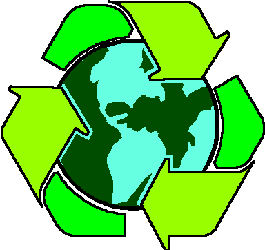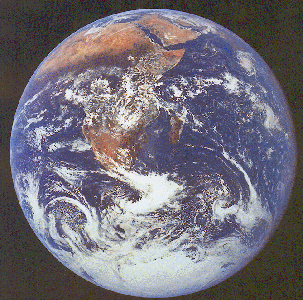| |
Earth Friendly Living:
 Each of us can lessen our impact on the environment and help conserve natural resources by making
changes in our daily lives. It all starts with a single step by each of us to build a healthy, prosperous, sustainable
environment for a new generation and hope for the planet. Each of us can lessen our impact on the environment and help conserve natural resources by making
changes in our daily lives. It all starts with a single step by each of us to build a healthy, prosperous, sustainable
environment for a new generation and hope for the planet.
On
the first Earth Day, April 22, 1970, an estimated 20 million Americans of all ages and from all
walks of life participated in celebrations from coast to coast, raising public awareness about
protecting and cleaning the nation's environment and conserving natural resources.
Today scientists tell us that global
climate changes resulting from increasing greenhouse gas emissions are expected to challenge
our water supply, agriculture, forestry, energy production, health, and transportation during
the coming decades. A global warming report issued April 6 by the United Nations Intergovernmental
Panel on Climate Change (IPCC) predicts a global warming of three degrees centigrade this
century, potentially resulting in millions of people short of drinking water, extreme food shortages
in Africa, and 20 - 30 percent of species at risk of extinction unless the warming trend is corrected.
Cleaning the air and water, controlling noise, and restoring ravaged landscapes are
all pieces of a large mosaic, lengthening lives and improving human well being by reducing the
poisons in our air, water, and soil. This is the ideal America we all cherish.
Learn about living a more "green", environmentally conscious lifestyle and reducing your own carbon
footprint:
1. Reduce the amount of the Earth's resources that we use
Small changes can add up to big differences, and it's simply a matter of managing your water
and energy consumption by eliminating waste and using only what you need.
Energy Use: Americans consume a disproportionate amount of the
world's energy resources, however, we can make a difference by conserving energy in our homes
and our daily lives. Nationally, the energy used in the average home can be responsible for
more than twice the greenhouse gas emissions of the average car. Using less energy at home
helps reduce greenhouse gas emissions from power plants and help protect our environment. A
few examples include:
- Reducing heating and cooling energy usage, the largest amount of energy used in American homes - this amount of energy can be reduced by adjusting the thermostat, programming the thermostat to reflect times you are and aren't home, (during Summer, when home set the thermostat to 76°-78°, when away 85°, Winter set the thermostat to 68° or lower during the day and evening, health permitting) and by better insulating our homes and by eliminating drafts;
- Washing clothes in cold water reduces the energy required to heat it, selecting a cold water detergent and using cold water will save 80 - 90% of the energy costs in washing;
- Limiting hot water use taking showers also reduces the energy required to heat it - pre 1992 showerheads typically put out 5 gallons of water a minute (GPM), newer showerheads put out less than 2.5 gallons of water per minute, some adjust down to as little as 1 gallon per minute; cutting shower time in half also reduces hot water usage;
- Turning off lights that aren't being used and replacing bulbs with compact florescent lamps (CFL) or lower wattage bulbs where possible - Energy Star CFL bulbs use at least 2/3 less energy than standard incandescent bulbs to provide the same amount of light, and last up to 10 times longer;
- Replacing older appliances with more energy efficient ones - Energy Star qualified appliances incorporate advanced technologies that use 10 to 50% less energy and water than standard models.
More energy saving tips are available from the Energy
Star, California's Flex Your Power, Energy Guide, Burbank's
Energy Saving Tips, and Green LA web sites.
Support for renewable electric energy sources also helps reduce green house emissions by reducing the percentage of power obtained from fossil fuel-burning power plants and increasing the percentage obtained from renewable energy sources, such as hydropower (water), solar,
wind, geothermal, and biomass. More information is available from the Re-Energy, National Renewable Energy Laboratory, US Department of Energy, California's Renewable Energy Program and Burbank's Green Energy Program.
 Water Use: California
communities face a strong possibility of water shortages and even mandatory rationing this summer because of record dry
weather in March and April, a fast-shrinking snowpack and below-normal reservoir levels, according to state officials. Water Use: California
communities face a strong possibility of water shortages and even mandatory rationing this summer because of record dry
weather in March and April, a fast-shrinking snowpack and below-normal reservoir levels, according to state officials.
We need to take a smarter, more efficient
approach to water management to continue to provide clean water for California farmers, businesses,
and a growing population. Many farmers have implemented irrigation water saving practices,
restaurants and other business have also developed ways to conserve water. Residents have also
been asked to reduce water use in their homes and yards. Suggestions include:
- Watering outdoor plants in the cooler hours and reducing watering frequency and amount
according to the weather may save 750 to 1,500 gallons a month;
- Repairing or replacing leaking faucets - repairing a faucet leaking
one drop per second saves roughly 200 gallons per month and repairing leaking toilets can save an average of 20 gallons
a day or 600 gallons per month;
- Bathroom showers, toilets, and sinks account for approximately 75% of the water used in our homes, a one- or two-minute shorter shower can save up to
700 gallons per month, turning off the water while brushing your teeth (2 minutes) should save approximately 150 gallons of water per month, low flow shower heads and toilets also reduce water use;
- Reducing water used rinsing and washing dishes, running only full loads in the washing
machine and dishwasher can save 300 to 800 gallons a month;
- Upgrading to more efficient appliances, shower heads and toilets can help save a substantial amount of water.
More specific water saving tips are available from Water
Use it Wisely, Be Water Wise, H2ouse
Water Saver Home, Metropolitan Water
District, and California Urban Water Council web sites.
Transportation: In California, transportation is the source of
more than half of the carbon dioxide emissions from fossil fuels. This can be reduced by reducing
the amount we drive when possible, consolidating trips, using mass transportation (provided
by MTA or Metrolink),
carpooling, walking or riding a bicycle where possible. Fuel conserving tips are available
at the Fuel Economy, Car
Talk, and Cars.com web sites.
Waste prevention: also refereed to as "source reduction,"
means consuming and throwing away less. Source reduction actually prevents the generation of
waste in the first place, so it is the most preferred method of waste management and goes a
long way toward protecting the environment. It includes:
- purchasing durable, long-lasting goods;
- seeking products and packaging that are as free of toxic's as possible;
- redesigning products to use less raw material in production, have a longer life, or be
used again after its original use.
2. Reuse - don't just toss it, could someone else make use of it?
Reuse starts with buying reusable items. When something is no longer needed, reuse becomes a simple concept "one person's
trash is another person's treasure." Repairing items, donating them to charity and community groups, or selling them
reduces waste. Reusing products, when possible, is even better than recycling because the item does not need to be reprocessed
before it can be used again. Ways to Reuse include:
- Using durable coffee mugs;
- Using cloth napkins or towels;
- Refilling bottles;
- Donating old magazines or surplus equipment;
- Reusing boxes;
- Turning empty jars into containers for leftover food;
- Purchasing refillable pens and pencils;
- Participating in a paint collection and reuse program.
Benefits of reuse include:
- Reuse keeps goods and materials out of the landfills,
- Reuse advances source reduction,
- Reuse preserves the “embodied energy” that was originally used to manufacture an item,
- Reuse reduces the strain on valuable resources, such as fuel, forests and water supplies, and helps safeguard wildlife
habitats,
- Reuse creates less air and water pollution than making a new item or recycling,
- Reuse reduces hazardous waste,
- Reuse saves money in purchases and disposal costs,
- Reuse creates an affordable supply of goods that are often of excellent quality.
Unique to reuse is that it also brings resources to individuals and organizations that might otherwise be unable to acquire
them. Several non-profit organizations accept donations of goods and materials and either give them to people in need or
sell the items in thrift stores to help raise needed funds. For more information visit: American
Cancer Society's Discovery Shops, Goodwill Industries, Out
of the Closet Thrift Stores and Salvation Army Thrift Stores.
More information about reusing is available at the California Waste
Management Board, LA Shares, and the Reuse Development
Organization (ReDO) reuse web sites.
3. Recycle - Can the materials be made into something new?
Recycling turns materials that would otherwise become waste into valuable resources. In addition,
it generates a host of environmental, financial, and social benefits. Materials like glass,
metal, plastics, and paper are collected, separated and sent to facilities that can process
them into new materials or products. Old computers and other electronic items can also be recycled.
Benefits of Recycling include:
- Conserves resources for our children's future;.
- Prevents emissions of many greenhouse gases and water pollutants;
- Saves energy;.
- Supplies valuable raw materials to industry;
- Creates jobs;
- Stimulates the development of greener technologies;
- Reduces the need for new landfills and incinerators.
Recycling is one of the best environmental success stories of the late 20th century. Recycling,
including composting, diverted 79 million tons of material away from landfills and incinerators
in 2005, up from 34 million tons in 1990. By 2002, almost 9,000 curbside collection programs
served roughly half of the American population. Curbside programs, along with drop-off and
buy-back centers, resulted in a diversion of about 32 percent of the nation's solid waste in
2005.
More information about recycling is available at the Earth
911, Burbank Recycling Center, Los Angeles Recycling
Program, National Recycling Coalition and your own city's web sites.
 Exploring Nature & Our Planet: Exploring Nature & Our Planet:
In March 1872, Congress established Yellowstone National Park beginning a worldwide national park movement. Today
our national parks include a network of nearly 400 natural, cultural and recreational sites across the nation. In
addition, states and local counties have established parks where peple can explore and enjoy these natural areas.
Learn more at our Exploring Nature & Our Planet links page.
Celebrate Earthday:
On the first Earth Day, April 22, 1970, an estimated 20 million Americans of all ages and from all walks of life
participated in celebrations from coast to coast, raising public awareness about protecting and cleaning the nation's
environment and conserving natural resources. Today Earth Day is a time to celebrate gains America has made including
cleaner air, cleaner water, reduction of solid waste, restoration of ravaged landscapes, and the creation of new
urban and national parks. Earth Day is also a time to to further our commitment to conservation and protection of
the environment, to reduce pollution and to reduce energy consumption.
Learn more at our Earthday links page.
Please note that Digital Network Express does not control the content of linked web sites, the organizations
who own these web sites accept sole responsibility for their content. Sites linked are provided for educational purposes
only. The existence of a link does not imply endorsement by Digital Network Express.
Entire web site copyright 2002-2011, DigitalNetExpress.com, Burbank, California. |
|
|



 Exploring Nature & Our Planet:
Exploring Nature & Our Planet: